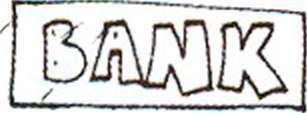
CATEGORIES:
BiologyChemistryConstructionCultureEcologyEconomyElectronicsFinanceGeographyHistoryInformaticsLawMathematicsMechanicsMedicineOtherPedagogyPhilosophyPhysicsPolicyPsychologySociologySportTourism
Commercial and retail banking
Commercial and retail banks
When people have more money than they need to spend, they may choose to save it. They deposit it in a bank account, at a commercial or retail bank, and the bank generally pays interest to the depositors. The bank then uses the money that has been deposited to grant loans - lend money to borrowers who need more money than they have available. Banks make a profit by charging a higher rate of interest to borrowers than they pay to depositors.
Commercial banks can also move or transfer money from one customer's bank account to another one, at the same or another bank, when the customer asks them to.
Credit
Banks also creatc credit - make money available for someone to borrow - because the money they lend, from their deposits, is usually spent and so transferred to another bank account.
The capital a bank has and the loans it has made are its assets. The customers' deposits are liabilities because the money is owed to someone else. Banks have to keep a certain percentage of their assets as reserves for borrowers who want to withdraw their money. This is known as the reserve requirement. For example, if the reserve requirement is 10%, a bank that receives a ˆ 100 deposit can lend ˆ90 of it. If the borrower spends the money and writes a cheque to someone who deposits the ˆ90, the bank receiving that deposit can lend ˆ81. As the process continues, the banking system can expand the first deposit of ˆ 100 into nearly ˆ 1,000. In this way, it creates credit of almost ˆ 900.
Loans and risks
Before lending money, a bank has to assess or calculate the risk involved. Generally, the greater the risk for the bank of not being repaid, the higher the interest rate they charge. Most retail banks have standardized products for personal customers, such as personal loans. This means that all customers who have been granted a loan have the same terms and conditions - they have the same rules for paying back the money.
Banks have more complicated risk assessment methods for corporate customers - business clients - but large companies these days prefer to raise their own finance rather than borrow from banks.



Banks have to find a balance between liquidity - having cash available when depositors want it - and different maturities - dates when loans will be repaid. They also have to balance yield - how much money a loan pays - and risk.

FOR. THE Convenience OF CUSTOMERS wis
8R/WCH HAS B££N MOVED TO TJ£R0\ PEL FUEGO WHKE IT WILL BE CPEN! CM ALTERNATE TOESPAy AfTBWcNS

/
/ /

20.1 Complete the sentences from banks' websites. Look at A and C opposite to help you.
—~ ——-——------------------------------------------------------------------------------------------------------------------------- —----------------------- —^--------------------------------------------------------------------------------------- ——
If you need instant access to all your money, this is the for you.
Our products for...................................................................... include business overdrafts, loan
repayments that reflect your cash flow, and commercial mortgages.

--------------------------------------------------------------------------------------------------------- :----------------------------------------------------------------------------------------------------- -—------------------------------------------------------------------------------------------------------ —---------------------------------------------------------------------------------------------------------- ---------------------------------------------------------------------------------------------------------- ----------------------------------------------------------------------------------------------------- —«---------------------------------------------------------------------------------------------------- .„-v.
Our local branch managers are encouraged to help local businesses and are authorized to and overdrafts.
We offer standardized loans: you can be sure you won't get less favourable terms and ....................... than our other...........................................................
20.2 Match the two parts of the sentences. Look at A, B and C opposite to help you.
1 Banks lend savers' deposits
2 They also create credit by
3 How much credit banks can create
4 Before lending money,
5 The interest rate on a loan
6 Banks always need liquidity,
a banks have to assess the risk involved, b depends on the reserve requirements, c depends on how risky it is for the bank to lend the money, d so they can't lend all their money in loans with long maturities, e lending the same original deposit several times, f to people who need to borrow money.
20.3 Find verbs in A, B and C opposite that can be used to make word combinations with the nouns below. Then use some of the verbs to complete the sentences.

risks
money
1 With standardized products, all customers are the same interest rate.
2 Banks generally know from experience how much cash to keep in their reserves for customers who want to............................... it.


3 Banks carefully study the financial situation of a company to the risk involved in
lending it money.
Ov^r ko ipu
Look at some commercial bank websites from your country. Which bank offers the best rates to borrowers and lenders?
Date: 2015-02-28; view: 8122
| <== previous page | | | next page ==> |
| Personal banking | | | Financial institutions |